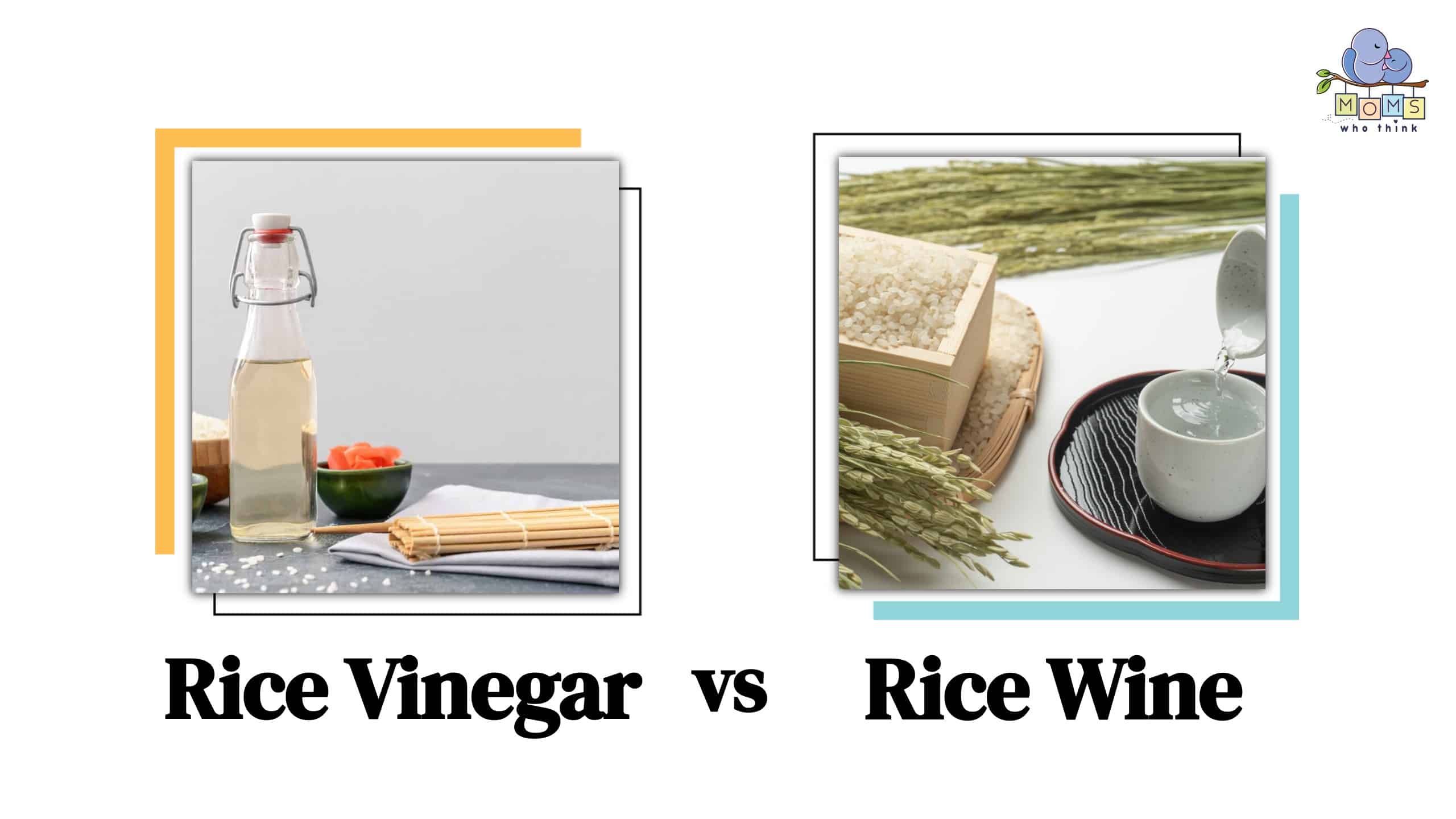Rice wine and rice wine vinegar are two cooking ingredients commonly seen in Asian households and Asian dishes. However, some people aren't familiar with the differences and even use each term interchangeably.
If you're also confused about the similarities and differences of each ingredient, then you're in the right place. In this article, we're going to talk about rice vinegar vs. rice wine. This article ought to help you differentiate the two and to know what to use the next time you're about to cook. So let's get started.
Rice Vinegar vs. Rice Wine: What's the Difference?
| Rice Vinegar | Rice Wine | |
|---|---|---|
| Production Process | Made by fermenting rice with yeast or starter culture. | Made by fermenting rice wine. |
| Taste | With a slight rice scent, it can be sweet or dry. | Tangy, acidic with a hint of sweetness. |
| Alcohol Content | 18 – 25% ABV | 0.5% maximum |
| Culinary Uses | Stir-fries Braised dishes Soups Sauces, and more. | Sushi rice Salads Pickles Stir rice and more. |
Rice Vinegar vs. Rice Wine: Similarities
Although rice wine and rice vinegar have a lot of differences when it comes to process, taste, alcohol content, and culinary uses, they also have a lot of similarities, such as:
- Both rice wine and vinegar are made of rice.
- They both undergo a fermentation process to be made.
- Both rice wine and rice vinegar are connected to Asian culinary traditions. It's being used in Asian dishes in various countries such as China, Japan, Korea, and Vietnam.
- Both rice wine and rice vinegar are used as a flavor enhancer.
Rice Vinegar vs. Rice Wine: Nutritional Value
They both have different nutritional values. Rice vinegar, made from fermented rice, has a tangy flavor and is low in calories, with no fat. It contains small amounts of minerals and vitamins, but its main benefit comes from acetic acid, which aids digestion and helps with weight management. On the other hand, rice wine, also called sake, is an alcoholic beverage made from fermented rice. It has more calories and alcohol content, and although it contains some vitamins and minerals, it is not the best choice for those looking for a low-calorie or alcohol-free option.
In addition to their nutritional differences, rice vinegar and rice wine also serve different culinary purposes. Rice vinegar is commonly used in dressings, marinades, and sauces to add a tangy flavor and as a natural preservative. It is popular in Asian cuisines, particularly sushi rice and stir-fries. On the other hand, rice wine is primarily used in cooking as a flavor enhancer and tenderizer for meats and seafood.
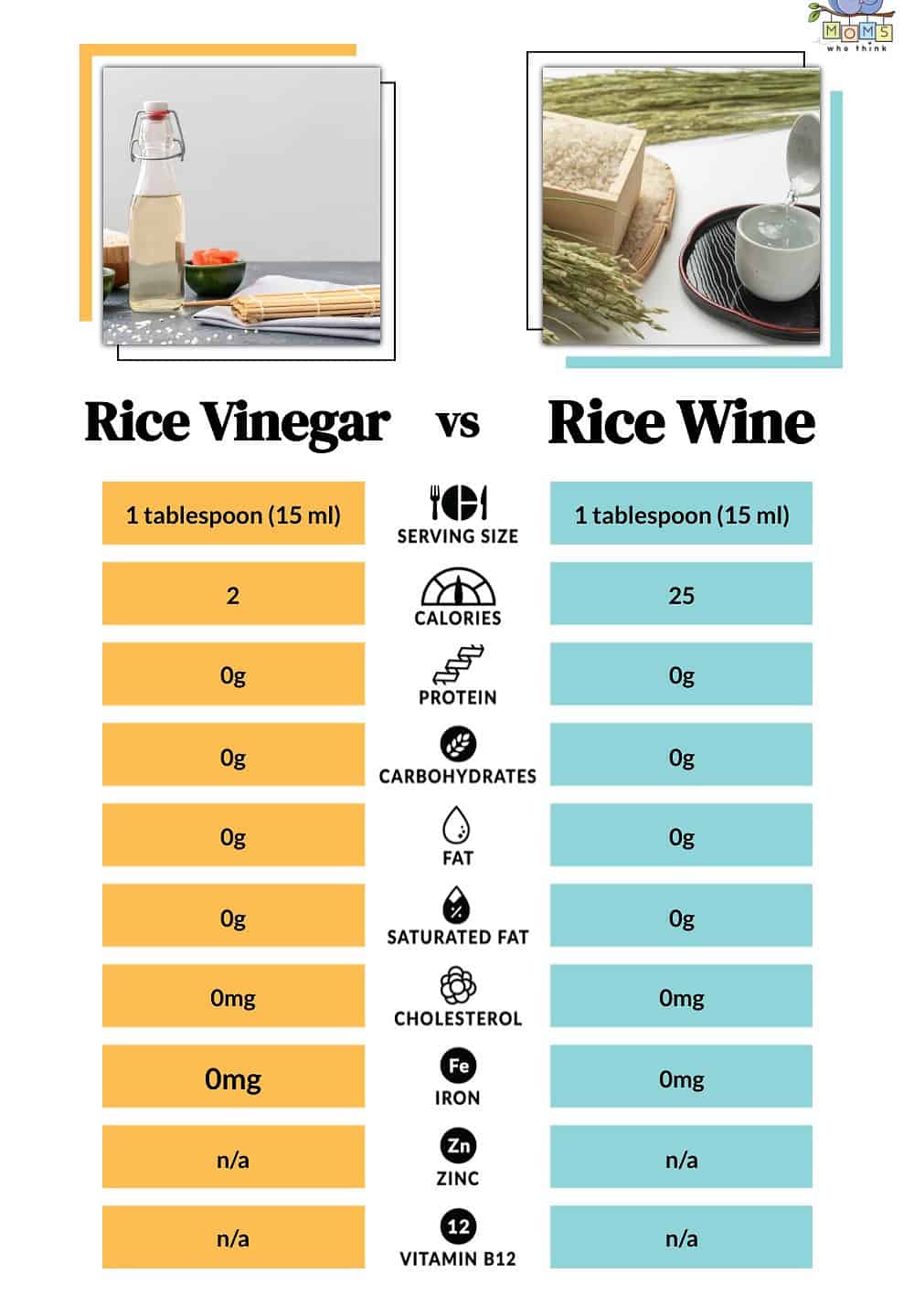
What is Rice Vinegar?
Rice vinegar has a milder flavor and hint of sweetness than the usual vinegar, like white vinegar or apple cider. What makes it unique is that it's made with rice, which is also why it has a hint of sweetness.
A rice vinegar undergoes a two-fermentation process. The first fermentation is to convert the rice into alcohol by soaking it and fermenting it with water for 3 – 5 days to enhance its nourishing power. After that, the second fermentation process comes in. The second fermentation process includes converting the rice alcohol into acetic acid, which takes 1 – 3 months.
After the fermentation processes, the rice vinegar should be aged for some time to develop its flavor further. It would then be filtered to remove the impurities.
What is Rice Wine?
Rice wine, similar to rice vinegar, is made from fermented rice. It is commonly used not just for cooking in an Asian household but also for drinking since it's a wine with a sweet and slightly sour flavor.
Rice vinegar and rice wine are made in the same manner. Actually, it comes in one stage before the process of creating rice vinegar.
Rice is fermented with yeast and a starting culture to create rice wine. It could turn into alcohol within a few days or over the course of a few weeks. Depending on the component used and the fermentation procedure, it might have varying degrees of sweetness and alcohol. Several varieties of rice may be used to make rice wine.
Some varieties of rice wine can be clear, white, or yellowish.
What is Rice Wine Used For?
Rice wine has a lot of uses, especially when it comes to cooking. For rice wine, here are some of the most common benefits of it when it comes to cooking.
- Cooking component – Rice wines are used as a garnish in Asian meals. It adds uniqueness to the dish and enriches its flavor. It also tenderizes meat by utilizing its acidity to break down the tough proteins in meat.
- Marinating – Rice wines are used to marinate meats and shellfish. It imparts spices and tenderizes the protein.
- Braising and simmering – Rice wine can also be used in braising and simmering.
- Steaming – Rice wine can also be used in steaming by adding water.
- Drinking – Rice wine is an alcoholic beverage that can be drunk directly.
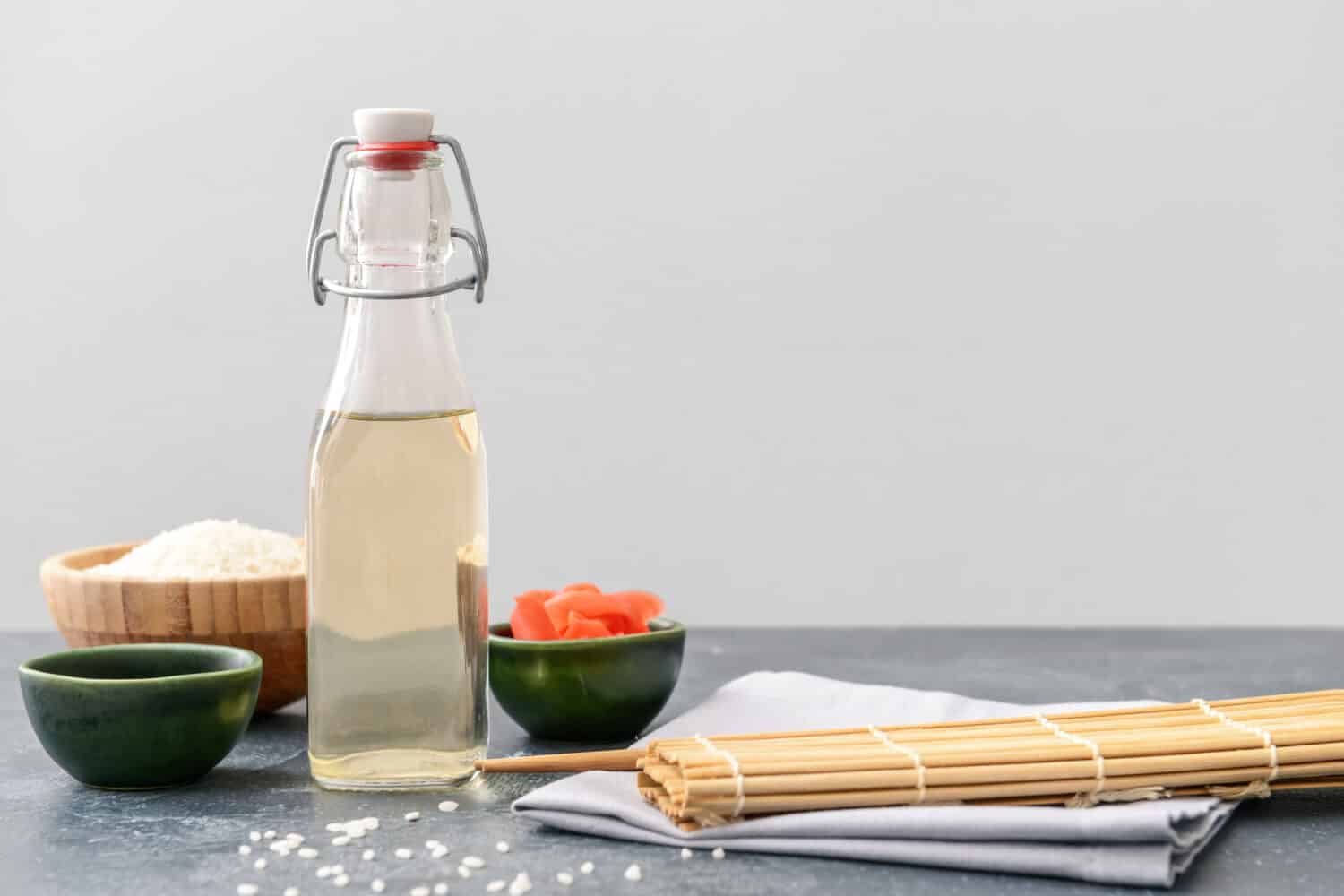
You can use rice vinegar in dressings, pickles, sushi rice, and much more.
©Pixel-Shot/Shutterstock.com
What is Rice Vinegar Used For?
Just like rice wine, rice vinegar also has a lot of uses when it comes to cooking. Here are some examples:
- Dressings – Rice vinegar can be used as a salad dressing by adding it to other ingredients. Since rice vinegar has a slightly sweet and sour flavor, it can be a good ingredient to balance the flavors of other ingredients.
- Pickles – Rice vinegar can add a mild, slightly sweet, and sour flavor to the pickles. It may also be used to store veggies.
- Sushi rice – Rice vinegar is commonly used in sushi rice because it imparts a somewhat acidic and sweet flavor.
- Dripping sauces – Rice vinegar may also be used in dipping sauces since it has a tart and balanced flavor.
Are Rice Vinegar and Rice Wine the Same?
No, rice vinegar and rice wine are not the same things, despite the fact that they are both derived from fermented rice. This means that rice wine and rice vinegar should not be confused and cannot be used interchangeably.
Rice wine is formed by fermenting rice with yeast, which turns the sugar in the rice into alcohol, whereas rice vinegar is made by fermenting rice wine.
Furthermore, rice wine is an alcoholic beverage, but rice vinegar has nearly little alcohol since the alcohol in rice wine was converted to acetic acid during the fermentation process, imparting a sour flavor to the rice vinegar.
History of Rice Wine and Rice Vinegar
As previously stated, rice wine and rice vinegar are two culinary components often used in Asian recipes. It is said to have originated in China and Japan. Rice wine and rice vinegar have been used for ages, but before they were employed as culinary components, they served religious and therapeutic functions.
Rice wine has been used for ancestor worship ceremonies, while rice vinegar has been used for medicinal purposes as it has a lot of health benefits for someone who consumes it.
Over time, rice wine and rice vinegar gained popularity in the culinary world. It was later introduced and spread to China's neighboring nations, including Japan and Korea. It also includes other Southeast Asian countries.
Rice wine and rice vinegar are still used for a number of purposes, most notably in cooking. Rice wine is consumed and cooked with, whilst rice vinegar is used in dressings, sauces, and other related applications.
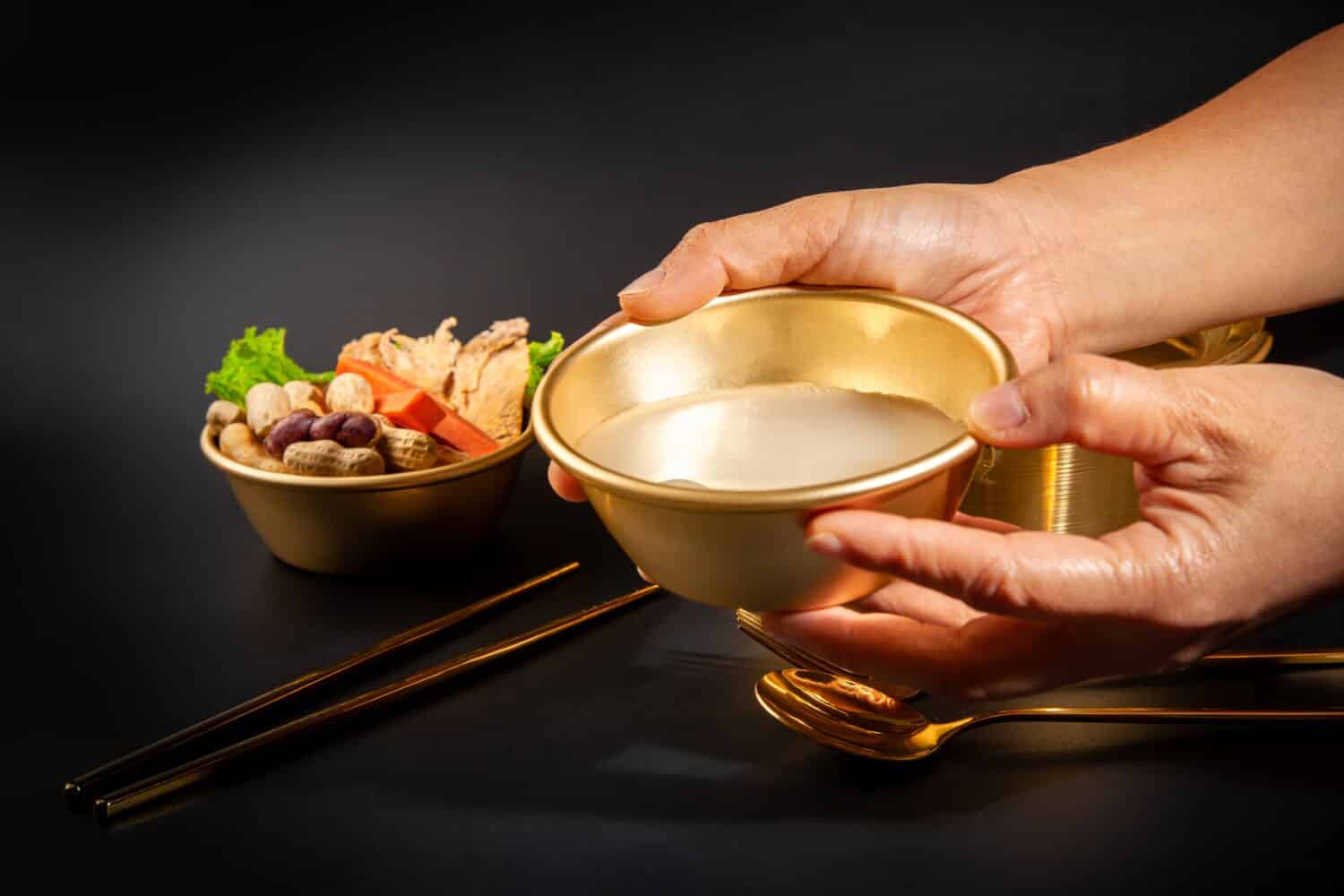
Some varieties of rice wine can be clear, white, or yellowish.
©Nitiphonphat/Shutterstock.com
Rice Vinegar Substitute
Although rice vinegar is easy to find, especially if you live in Asia, the home of rice vinegar, you may also wonder what the possible alternatives to rice vinegar are.
Although rice vinegar is an easy commodity to get, especially if you live in Asia, you may need an alternative if you run out or don't have time to buy it. So here are five alternatives to rice vinegar that you can use in case that happens:
Apple cider
It is the perfect substitute because apple cider has a similar flavor profile to rice wine. Both apple cider and rice wine are derived from fermented fruits, so they have much in common. Furthermore, apple cider and rice wine have a sweet and somewhat sour flavor. It's also less acidic, so you can be confident it won't overpower your food.
White Wine Vinegar
You may also use white wine vinegar as a substitute for rice vinegar. Although it is more acidic than rice vinegar, it is mild, which is a rice vinegar trait. Because of its acidity, it, like rice vinegar, may tenderize meat. White vinegar is also produced through the fermentation process.
It has a natural flavor that helps it to combine nicely with other components in your meal. Finally, white vinegar is widely accessible, so it's easy to find and has a long shelf life.
Champagne Vinegar
Champagne vinegar is a versatile ingredient that can be used in a wide range of recipes. This characteristic of champagne vinegar makes it a good alternative to rice vinegar.
Like rice vinegar, champagne vinegar can also be used in vinaigrettes, sauces, pickles, and desserts. Just like the other vinegar, it also underwent a fermentation process. It has a mild flavor similar to rice wine and good acidity.
Lemon or Lime Juice
Lemon or lime juice is an all-natural item that can be used in place of rice vinegar. It may also be used in a variety of dishes. Lemon and lime juices are both acidic. It has a tangy flavor that adds zesty flavor to the meal and is a wonderful substitute for rice vinegar.
Mirin (Rice Wine)
Last but not least is the mirin or rice wine. This is the closest alternative to rice vinegar because of its shared origin and similar flavor profile. It has a subtle sweetness, milder acidity, and flavor complexity that's good for enhancing the flavor of a dish.
Final Thoughts
In conclusion, rice vinegar and rice wine are two unique ingredients commonly used in Asian-inspired cuisines. Although these two substances' origins and manufacturing processes are quite similar, they shouldn't be used interchangeably.
Rice wine and rice vinegar serve distinct purposes and have diverse applications, so you should know when and where you can use each of them.
Thank you for reading, and I hope the article helped you understand the differences and similarities between rice wine and rice vinegar.
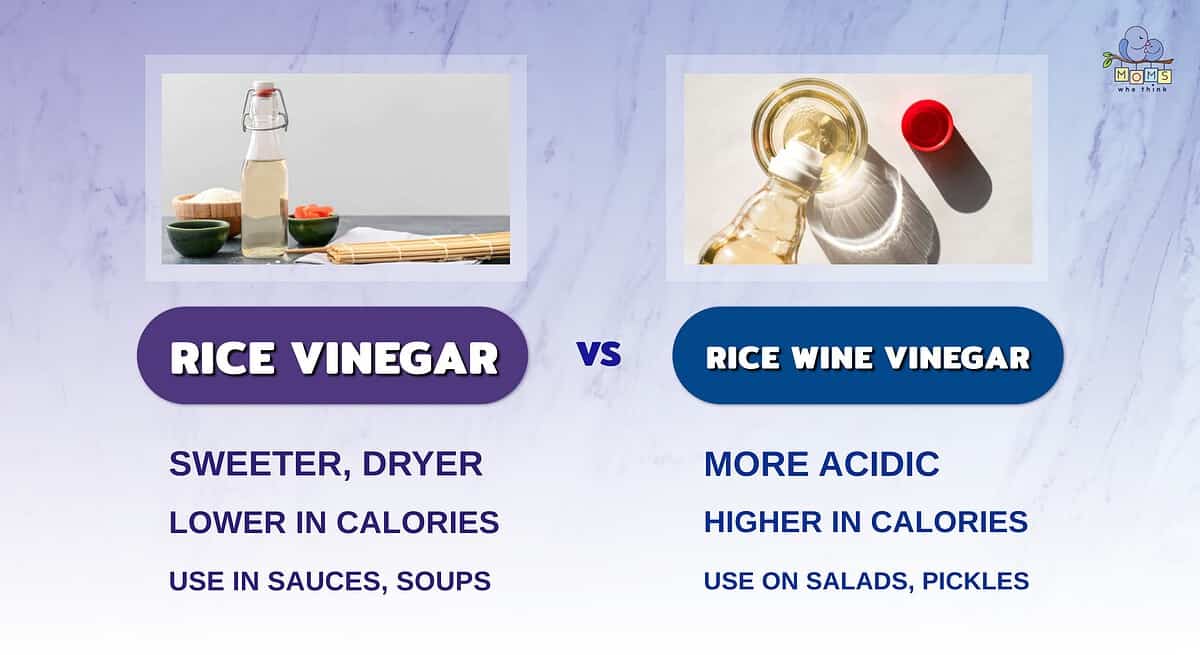
While these two may have many similarities, they surprisingly have some distinct differences. Here's a recap of the differences between the two:
- One large difference between rice vinegar and rice wine vinegar is the alcohol content. Rice vinegar typically has more alcohol content than that of rice wine.
- Rice wine vinegar is great in salads, sushi, and even pickles. On the other hand, rice vinegar is great for braised dishes and soups.
- One of the main differences is the Taste. Rice wine vinegar is more Tangy and acidic, while rice vinegar is typically sweeter.
Looking for a reason to use rice vinegar? Check out this sesame chicken with broccoli:
Print
Sesame Chicken with Broccoli
- Yield: Serves 4
Ingredients
5 tablespoons reduced-sodium soy sauce
4 teaspoons toasted sesame oil
5 teaspoons honey
1¼ pounds skinless, boneless chicken breasts, cut into 1-inch chunks
2 tablespoons canola oil
1 small head broccoli, cut into florets
2 scallions, thinly sliced, 2 tablespoons greens reserved
1 tablespoon grated fresh ginger
3 cloves garlic, minced
1 ½ cups low-sodium chicken broth
4 teaspoons cornstarch
1 tablespoon rice vinegar
1 teaspoon chili paste
3 tablespoons toasted sesame seeds
Cooked brown rice, for serving (optional)
Instructions
1. In a medium bowl, whisk together 3 tablespoons soy sauce, 2 teaspoons sesame oil, and 2 teaspoons honey.
2. Add the chicken, toss to coat, and marinate for 20 minutes.
3. Heat 2 teaspoons canola oil in a large nonstick skillet over medium-high heat.
4. Remove the chicken from the marinade with a slotted spoon and discard the marinade.
5. Add half of the chicken to the pan and cook until browned and cooked through, turning once or twice, about 6 minutes. Transfer the chicken to a large serving platter.
6. Repeat with 2 more teaspoons of canola oil and the remaining chicken. Transfer to the serving plate.
7. Add the broccoli to the pan along with 2 tablespoons water, cover and steam for 4 minutes.
8. Create a hole in the broccoli by pushing it aside and heat the remaining 2 teaspoons canola oil in the skillet over medium-high heat. Add the scallions, ginger, and garlic and cook, stirring until fragrant, 1 to 2 minutes.
9. In a small bowl, whisk together the broth, the remaining 2 tablespoons soy sauce, the remaining 3 teaspoons honey, the cornstarch, vinegar, and chili paste until the cornstarch and honey are dissolved. Add the mixture to the pan and cook, stirring, until the mixture is thickened and darkened in color, 2 to 3 minutes.
10. Stir in the remaining 2 teaspoons sesame oil.
11. Pour the sauce and broccoli mixture over the chicken. Sprinkle with the sesame seeds and 2 tablespoons scallion greens. Serve with brown rice, if desired.
Nutrition
- Serving Size: Per serving
- Calories: 410
- Sodium: 730mg
- Fat: 18g
- Saturated Fat: 3g
- Carbohydrates: 29g
- Fiber: 4g
- Protein: 36g
- Cholesterol: 90mg
